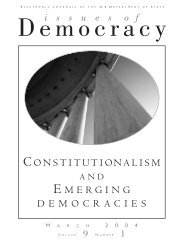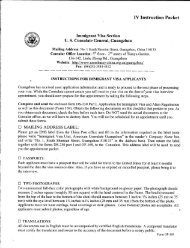s. history us history us history - Embassy of the United States
s. history us history us history - Embassy of the United States
s. history us history us history - Embassy of the United States
- No tags were found...
You also want an ePaper? Increase the reach of your titles
YUMPU automatically turns print PDFs into web optimized ePapers that Google loves.
CHAPTER 14: THE NEW CONSERVATISM AND A NEW WORLD ORDEROUTLINE OF U.S. HISTORYpresidency, Reagan announced <strong>the</strong>Strategic Defense Initiative (SDI) researchprogram to explore advancedtechnologies, such as lasers andhigh-energy projectiles, to defendagainst intercontinental ballisticmissiles. Although many scientistsquestioned <strong>the</strong> technological feasibility<strong>of</strong> SDI and economists pointedto <strong>the</strong> extraordinary sums <strong>of</strong> moneyinvolved, <strong>the</strong> administration pressedahead with <strong>the</strong> project.After re-election in 1984, Reagans<strong>of</strong>tened his position on armscontrol. Moscow was amenable toagreement, in part beca<strong>us</strong>e its economyalready expended a far greaterproportion <strong>of</strong> national output on itsmilitary than did <strong>the</strong> <strong>United</strong> <strong>States</strong>.Fur<strong>the</strong>r increases, Soviet leaderMikhail Gorbachev felt, wouldcripple his plans to liberalize <strong>the</strong>Soviet economy.In November 1985, Reagan andGorbachev agreed in principleto seek 50-percent reductions instrategic <strong>of</strong>fensive nuclear arms aswell as an interim agreement onintermediate-range nuclear forces.In December 1987, <strong>the</strong>y signed <strong>the</strong>Intermediate-Range Nuclear Forces(INF) Treaty providing for <strong>the</strong> destruction<strong>of</strong> that entire category<strong>of</strong> nuclear weapons. By <strong>the</strong>n, <strong>the</strong>Soviet Union seemed a less menacingadversary. Reagan could takemuch <strong>of</strong> <strong>the</strong> credit for a greatly diminishedCold War, but as his administrationended, almost no onerealized j<strong>us</strong>t how shaky <strong>the</strong> USSRhad become.THE PRESIDENCY OFGEORGE H. W. BUSHPresident Reagan enjoyed un<strong>us</strong>uallyhigh popularity at <strong>the</strong> end <strong>of</strong>his second term in <strong>of</strong>fice, but under<strong>the</strong> terms <strong>of</strong> <strong>the</strong> U.S. Constitutionhe could not run again in 1988. TheRepublican nomination went to VicePresident George Herbert WalkerB<strong>us</strong>h, who was elected <strong>the</strong> 41st president<strong>of</strong> <strong>the</strong> <strong>United</strong> <strong>States</strong>.B<strong>us</strong>h campaigned by promisingvoters a continuation <strong>of</strong> <strong>the</strong>prosperity Reagan had brought. Inaddition, he argued that he wouldsupport a strong defense for <strong>the</strong><strong>United</strong> <strong>States</strong> more reliably than<strong>the</strong> Democratic candidate, MichaelDukakis. He also promised to workfor “a kinder, gentler America.”Dukakis, <strong>the</strong> governor <strong>of</strong> Massach<strong>us</strong>etts,claimed that less fortunateAmericans were hurting economicallyand that <strong>the</strong> government hadto help <strong>the</strong>m while simultaneo<strong>us</strong>lybringing <strong>the</strong> federal debt and defensespending under control. Thepublic was much more engaged,however, by B<strong>us</strong>h’s economic message:No new taxes. In <strong>the</strong> balloting,B<strong>us</strong>h finished with a 54-to-46-percentpopular vote margin.During his first year in <strong>of</strong>fice,B<strong>us</strong>h followed a conservative fiscalprogram, pursuing policies on taxes,spending, and debt that were faithfulto <strong>the</strong> Reagan administration’s economicprogram. But <strong>the</strong> new presidentsoon found himself squeezedbetween a large budget deficit and adeficit-reduction law. Spending cutsseemed necessary, and B<strong>us</strong>h possessedlittle leeway to introduce newbudget items.The B<strong>us</strong>h administration advancednew policy initiatives in areasnot requiring major new federalexpenditures. Th<strong>us</strong>, in November1990, B<strong>us</strong>h signed sweeping legislationimposing new federal standardson urban smog, automobile exha<strong>us</strong>t,toxic air pollution, and acid rain,but with ind<strong>us</strong>trial polluters bearingmost <strong>of</strong> <strong>the</strong> costs. He acceptedlegislation requiring physical accessfor <strong>the</strong> disabled, but with no federalassumption <strong>of</strong> <strong>the</strong> expense <strong>of</strong>modifying buildings to accommodatewheelchairs and <strong>the</strong> like. Thepresident also launched a campaignto encourage volunteerism, whichhe called, in a memorable phrase, “atho<strong>us</strong>and points <strong>of</strong> light.”BUDGETS AND DEFICITSB<strong>us</strong>h administration efforts togain control over <strong>the</strong> federal budgetdeficit, however, were more problematic.One source <strong>of</strong> <strong>the</strong> difficulty was<strong>the</strong> savings and loan crisis. Savingsbanks — formerly tightly regulated,low-interest safe havens for ordinarypeople — had been deregulated, allowing<strong>the</strong>se institutions to competemore aggressively by paying higherinterest rates and by making riskierloans. Increases in <strong>the</strong> government’sdeposit insurance guaranteed reducedconsumer incentive to shunless-sound institutions. Fraud,mismanagement, and <strong>the</strong> choppyeconomy produced widespread insolvenciesamong <strong>the</strong>se thrifts (<strong>the</strong>umbrella term for consumer-orientedinstitutions like savings and loanassociations and savings banks). By1993, <strong>the</strong> total cost <strong>of</strong> selling andshuttering failed thrifts was staggering,nearly $525,000-million.In January 1990, President B<strong>us</strong>hpresented his budget proposal toCongress. Democrats argued thatadministration budget projectionswere far too optimistic, and thatmeeting <strong>the</strong> deficit-reduction lawwould require tax increases andsharper cuts in defense spending.That June, after protracted negotiations,<strong>the</strong> president agreed to a taxincrease. All <strong>the</strong> same, <strong>the</strong> combination<strong>of</strong> economic recession, lossesfrom <strong>the</strong> savings and loan ind<strong>us</strong>tryrescue operation, and escalatinghealth care costs for Medicare andMedicaid <strong>of</strong>fset all <strong>the</strong> deficit-reductionmeasures and produced ashortfall in 1991 at least as large as<strong>the</strong> previo<strong>us</strong> year’s.END TO THE COLD WARWhen B<strong>us</strong>h became president,<strong>the</strong> Soviet empire was on <strong>the</strong> verge<strong>of</strong> collapse. Gorbachev’s efforts toopen up <strong>the</strong> USSR’s economy appearedto be floundering. In 1989,<strong>the</strong> Communist governments inone Eastern European country afterano<strong>the</strong>r simply collapsed, afterit became clear that R<strong>us</strong>sian troopswould not be sent to prop <strong>the</strong>m up.In mid-1991, hard-liners attempteda coup d’etat, only to be foiled byGorbachev rival Boris Yeltsin, presi-314315












